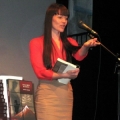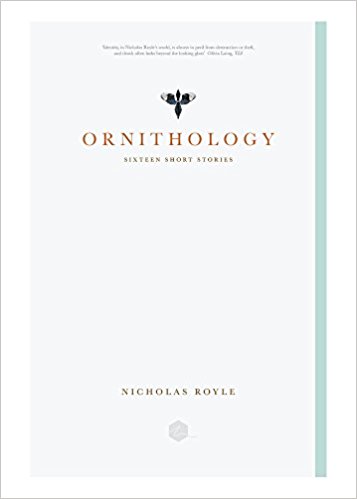You have no items in your cart. Want to get some nice things?
Go shoppingI was attracted to this collection because of the title and the strikingly simple cover design. I like themed collections and I wondered how the author would handle the study of birds. What could be borne out of a series of short stories framed in this way?
Reading the first few pieces in the collection, I found I liked Royle’s writing and enjoyed his economy of language. For example, ‘she responds to my response’. The often functional writing sometimes seemed to be representative of the weary mechanics of relationships and the well-worn tread of our own lives, with the protagonists often demonstrating some intense desire for life to be less ordinary, or for us to appreciate the wider world we live in, or for life just to be more. The stories often concentrated on an aspect of the bird represented within the title (e.g. ‘Gannets’) and magnified that in some way. Within this taut writing, however, there were moments of vigorous and evocative description that were all the more illuminated because of the control otherwise demonstrated within the prose – ‘the wind ripped the tops off the waves’; ‘the taste of the grave is in my mouth’. They are all the more effective because of their relative sparsity.
Several stories utilised metamorphosis well, surprising us with creepy and creeping endings. I can still see one of the characters’ heads being able to turn all the way around. I felt that this was not just an attempt to surprise us, but also to draw connection to the importance of nature and how we are so careless with it. One such image sticks with me even now, of ‘the scarlet faces of pheasants hanging by their feet’, and how, when you do actually stop to think about what we have become so used to seeing, this is alarmingly ruthless and barbaric. Here is something that was alive. It has been flayed, tied at the heels, hung up like a decoration. How have we become so casually cruel? What I found interesting about such descriptions was that the detail is given to you, almost offered and not overly unpacked. Reading the rest of the collection in its entirety is what seems to do that job for you, allowing you to draw parallels and taking up those early suggestions and reinforcing them.
I was just at the point with the collection where I wondered where else the author could take the stories. Would it be populated with work like this, would it make similar points and use the same technique, a character taking on the traits of a bird?
And then the strangest thing happened. It felt as if all the smaller, subtle elements of the early stories started to take on a larger importance and complexity as I progressed through them. The slow, creeping horror that pervades the entire collection coalesced, strong, affective. On the face of it, the stories can be read quickly; put together, they create an incredibly dense and large dimension to explore as you’re reading and after you’re done. I slowed down with my reading, I allowed space between the stories and I let myself think and wonder and question.
Of the motifs that kept returning for me, blindness, blighted nature and metamorphosis, it was blindness that recurred the most. One of my favourite, and strangest, stories is ‘The Lure’, which is about a professor in Paris who has a brief affair with a French lecturer. A blind man seems to watch him on the train from behind glasses painted with unblinking eyes. That night I dreamed about that man and his eyes. The image is so unnerving and yet the supposedly blind man isn’t blind at all and has been watching the development of the affair. I suppose my next step was to wonder about how this fitted into the larger ideas at work behind the collection. Perhaps the suggestion is that although we often look away from things, generating a sense of blindness, we’re not really. Something that we all think is a secret, including the professor, is actually being thoroughly observed. It made me ask, and I continue to ask, questions about what this could mean. Why might we suppose blindness in others when we ourselves are keenly observing? What are the benefits? What are the drawbacks? How can this writing make us think back on the things we choose to see or avoid seeing?
As I said, part of the reason I was attracted to this collection was its title and I can’t avoid the pun – that it really takes flight in the latter half. All of the stories work in symbiosis with each other, build into something greater than the words on the page and as such, become an example of the execution of some serious skill. These are stories to be savoured.
Ornithology is published by Cōnfingō.

About Sarah Dobbs
Sarah Dobbs is a lecturer in English and Creative Writing. Her novel, Killing Daniel, was published by Unthank Books in 2012. Previous work has been broadcast by the BBC, published by Flax, SWAMP and Step Away Magazine. She is currently editing a textbook for English and Creative Writing students.





